Microstructure and High-Temperature Mechanical Properties of Mg-1Al-12Y Alloy Containing LPSO Phase
Abstract
:1. Introduction
2. Experimental Produces
3. Results
3.1. Microstructure of the As-Cast Alloy
3.2. Microstructure of the Solution Treated Mg-1Al-12Y Alloy
3.3. Mechanical Properties
4. Discussion
5. Conclusions
Author Contributions
Funding
Data Availability Statement
Acknowledgments
Conflicts of Interest
References
- Pollock, T.M. Weight Loss with Magnesium Alloys. Science 2010, 328, 986–987. [Google Scholar] [CrossRef] [PubMed]
- Hwang, J.H.; Zargaran, A.; Park, G.; Lee, O.; Lee, B.-J.; Kim, N.J. Effect of 1Al addition on deformation behavior of Mg. J. Magnes. Alloy. 2021, 9, 489–498. [Google Scholar] [CrossRef]
- Wang, Q.; Jiang, B.; Chen, D.; Jin, Z.; Zhao, L.; Yang, Q.; Huang, G.; Pan, F. Strategies for enhancing the room-temperature stretch formability of magnesium alloy sheets: A review. J. Mater. Sci. 2021, 56, 12965–12998. [Google Scholar] [CrossRef]
- Jung, Y.-G.; Yang, W.; Kim, Y.J.; Kim, S.; Yoon, Y.-O.; Lim, H.; Kim, D.H. Effect of Ca addition on the microstructure and mechanical properties of heat-treated Mg-6.0Zn-1.2Y-0.7Zr alloy. J. Magnes. Alloy. 2021, 9, 1619–1631. [Google Scholar] [CrossRef]
- Chaudry, U.M.; Tekumalla, S.; Gupta, M.; Jun, T.-S.; Hamad, K. Designing highly ductile magnesium alloys: Current status and future challenges. Crit. Rev. Solid State Mater. Sci. 2021, 47, 194–281. [Google Scholar] [CrossRef]
- Yokobayashi, H.; Kishida, K.; Inui, H.; Yamasaki, M.; Kawamura, Y. Enrichment of Gd and Al atoms in the quadruple close packed planes and their in-plane long-range ordering in the long period stacking-ordered phase in the Mg–Al–Gd system. Acta Mater. 2011, 59, 7287–7299. [Google Scholar] [CrossRef]
- Mayama, T.; Agnew, S.R.; Hagihara, K.; Kamura, K.; Shiraishi, K.; Yamasaki, M.; Kawamura, Y. α-Mg/LPSO (Long-Period Stacking Ordered) phase interfaces as obstacles against dislocation slip in as-cast Mg-Zn-Y alloys. Int. J. Plast. 2022, 154, 103294. [Google Scholar] [CrossRef]
- Yin, W.; Briffod, F.; Shiraiwa, T.; Enoki, M. Mechanical properties and failure mechanisms of Mg-Zn-Y alloys with different extrusion ratio and LPSO volume fraction. J. Magnes. Alloy. 2022, 10, 2158–2172. [Google Scholar] [CrossRef]
- Gu, X.-F.; Furuhara, T.; Chen, L.; Yang, P. Domain structures and the transitional state of ordering in long-period stacking ordered (LPSO) structures in Mg–Al–Gd alloy. Scr. Mater. 2020, 187, 19–23. [Google Scholar] [CrossRef]
- Kim, H.; Ross, A.J.; Shang, S.-L.; Wang, Y.; Kecskes, L.J.; Liu, Z.-K. First-principles calculations and thermodynamic modelling of long periodic stacking ordered (LPSO) phases in Mg-Al-Gd. Materialia 2018, 4, 192–202. [Google Scholar] [CrossRef]
- Wang, Y.; Zhang, Y.; Wang, P.; Zhang, D.; Yu, B.; Xu, Z.; Jiang, H. Effect of LPSO phases and aged-precipitations on corrosion behavior of as-forged Mg–6Gd–2Y–1Zn–0.3Zr alloy. J. Mater. Res. Technol. 2020, 9, 7087–7099. [Google Scholar] [CrossRef]
- Jeong, H.T.; Kim, W.J. The hot compressive deformation behavior of cast Mg-Gd-Y-Zn-Zr alloys with and without LPSO phase in their initial microstructures. J. Magnes. Alloy. 2022, 10, 2901–2917. [Google Scholar] [CrossRef]
- Hao, Y.; Chen, X.; Zhao, Z.; Chen, Z.; Chen, B. The interface between long-period stacking-ordered (LPSO) structure and β’ phase in Mg-Gd-Al alloys. J. Alloy. Compd. 2022, 923, 166267. [Google Scholar] [CrossRef]
- Nishimoto, S.; Koguchi, Y.; Yamasaki, M.; Kawamura, Y. Effect of hierarchical multimodal microstructure evolution on tensile properties and fracture toughness of rapidly solidified Mg–Zn–Y–Al alloys with LPSO phase. Mater. Sci. Eng. A 2022, 832, 142348. [Google Scholar] [CrossRef]
- Yang, Q.; Guan, K.; Li, B.; Meng, F.; Lv, S.; Yu, Z.; Zhang, X.; Zhang, J.; Meng, J. Coexistence of 14H and 18R-type long-period stacking ordered (LPSO) phases following a novel orientation relationship in a cast Mg−Al−RE−Zn alloy. J. Alloy. Compd. 2018, 766, 902–907. [Google Scholar] [CrossRef]
- Shi, R. Nonisothermal dissolution kinetics on Mg17Al12 intermetallic in Mg-Al alloys. J. Magnes. Alloy. 2021, 10, 2421–2432. [Google Scholar] [CrossRef]
- Korgiopoulos, K.; Pekguleryuz, M. The significant effect of trace yttrium level on the mechanical properties of cast Mg–6Al alloy through a refinement mechanism. Mater. Sci. Eng. A 2020, 775, 138966. [Google Scholar] [CrossRef]
- Wang, J.H. Study on Static and Dynamic Mechanical Behavior of Mg-Al-Y Alloys. Ph.D. Thesis, Shenyang University of Technology, Shenyang, China, 2021. [Google Scholar] [CrossRef]
- Li, Y.; Yang, C.; Zeng, X.; Jin, P.; Qiu, D.; Ding, W. Microstructure evolution and mechanical properties of magnesium alloys containing long period stacking ordered phase. Mater. Charact. 2018, 141, 286–295. [Google Scholar] [CrossRef]
- Hagihara, K.; Okamoto, T.; Izuno, H.; Yamasaki, M.; Matsushita, M.; Nakano, T.; Kawamura, Y. Plastic deformation behavior of 10H-type synchronized LPSO phase in a Mg–Zn–Y system. Acta Mater. 2016, 109, 90–102. [Google Scholar] [CrossRef]
- Jiang, M.; Zhang, S.; Bi, Y.; Li, H.; Ren, Y.; Qin, G. Phase equilibria of the long-period stacking ordered phase in the Mg–Ni–Y system. Intermetallics 2015, 57, 127–132. [Google Scholar] [CrossRef]
- Nie, J.F.; Zhu, Y.M.; Morton, A.J. On the Structure, Transformation and Deformation of Long-Period Stacking Ordered Phases in Mg-Y-Zn Alloys. Met. Mater. Trans. A 2014, 45, 3338–3348. [Google Scholar] [CrossRef]
- Peng, Z.; Shao, X.; Liang, Z.; Wang, D.; Wang, L.; Ma, X. Synergetic deformation mechanisms in an Mg-Zn-Y-Zr alloy with intragranular LPSO structures. J. Magnes. Alloy. 2022. [Google Scholar] [CrossRef]
- Matsuda, M.; Ii, S.; Kawamura, Y.; Ikuhara, Y.; Nishida, M. Variation of long-period stacking order structures in rapidly solidified Mg97Zn1Y2 alloy. Mater. Sci. Eng. A 2005, 393, 269–274. [Google Scholar] [CrossRef]
- Chen, Y.; Li, Q.; Li, Y.; Zheng, W.; Wang, J.; Zeng, X. Phase equilibria of long-period stacking ordered phase in the ternary Mg-Y-Al alloys. J. Mater. Sci. Technol. 2022, 126, 80–92. [Google Scholar] [CrossRef]
- Yuan, S.; Wang, J.; Li, X.; Ma, H.; Zhang, L.; Jin, P. Enhanced mechanical properties of Mg-1Al-12Y alloy containing long period stacking ordered phase. J. Magnes. Alloy. 2022. [Google Scholar] [CrossRef]
- Zhu, Q.; Shang, X.; Zhang, H.; Qi, X.; Li, Y.; Zeng, X. Influence of Al2Y particles on mechanical properties of Mg-11Y-1Al alloy with different grain sizes. Mater. Sci. Eng. A 2022, 831, 142166. [Google Scholar] [CrossRef]
- Su, C.; Wang, J.; Hu, H.; Wen, Y.; Liu, S.; Ma, K. Enhanced strength and corrosion resistant of Mg-Gd-Y-Al alloys by LPSO phases with different Al content. J. Alloy. Compd. 2021, 885, 160557. [Google Scholar] [CrossRef]
- Kim, J.; Kawamura, Y. Influence of Rare Earth Elements on Microstructure and Mechanical Properties of Mg97Zn1Y1RE1 Alloys. Mater. Sci. Eng. A 2013, 573, 62–66. [Google Scholar] [CrossRef]
- Hu, Z.; Qi, Y.; Nie, X.; Zhang, H.; Zhu, H. The Portevin-Le Chatelier (PLC) effect in an Al-Cu aluminum alloy fabricated by selective laser melting. Mater. Charact. 2021, 178, 111198. [Google Scholar] [CrossRef]
- Sun, H.-F.; Li, C.-J.; Fang, W.-B. Evolution of microstructure and mechanical properties of Mg–3.0Zn–0.2Ca–0.5Y alloy by extrusion at various temperatures. J. Mater. Process. Technol. 2016, 229, 633–640. [Google Scholar] [CrossRef]
- Li, C.; Liu, H.; Xin, Y.; Guan, B.; Huang, G.; Wu, P.; Liu, Q. Achieving ultra-high strength using densely ultra-fine LPSO phase. J. Mater. Sci. Technol. 2022, 129, 135–138. [Google Scholar] [CrossRef]
- Hagihara, K.; Kinoshita, A.; Sugino, Y.; Yamasaki, M.; Kawamura, Y.; Yasuda, H.; Umakoshi, Y. Effect of long-period stacking ordered phase on mechanical properties of Mg97Zn1Y2 extruded alloy. Acta Mater. 2010, 58, 6282–6293. [Google Scholar] [CrossRef]
- del Valle, J.; Carreño, F.; Ruano, O. Influence of texture and grain size on work hardening and ductility in magnesium-based alloys processed by ECAP and rolling. Acta Mater. 2006, 54, 4247–4259. [Google Scholar] [CrossRef]
- Li, C.; Malik, A.; Nazeer, F.; Chaudry, U.M.; Long, J.; Wang, Y. A strong, ductile and in-plane tensile isotropic Mg-0.5Zn-0.5Y-0.15Si alloy. J. Mater. Res. Technol. 2022, 20, 3344–3354. [Google Scholar] [CrossRef]
- Gong, W.; Aizawa, K.; Harjo, S.; Zheng, R.; Kawasaki, T.; Abe, J.; Kamiyama, T.; Tsuji, N. Deformation behavior of as-cast and as-extruded Mg97Zn1Y2 alloys during compression, as tracked by in situ neutron diffraction. Int. J. Plast. 2018, 111, 288–306. [Google Scholar] [CrossRef]
- Yamasaki, S.; Tokuzumi, T.; Li, W.; Mitsuhara, M.; Hagihara, K.; Fujii, T.; Nakashima, H. Kink Formation Process in Long-Period Stacking Ordered Mg-Zn-Y Alloy. Acta Mater. 2020, 195, 25–34. [Google Scholar] [CrossRef]
- Pan, H.; Kang, R.; Li, J.; Xie, H.; Zeng, Z.; Huang, Q.; Yang, C.; Ren, Y.; Qin, G. Mechanistic investigation of a low-alloy Mg–Ca-based extrusion alloy with high strength–ductility synergy. Acta Mater. 2020, 186, 278–290. [Google Scholar] [CrossRef]
- Zhao, D.; Chen, X.; Li, J.; Tan, J.; Pan, F. Microstructure, texture and mechanical properties of the rolled high modulus Mg-Y-Zn-Al-Li alloy. Mater. Sci. Eng. A 2022, 831, 142242. [Google Scholar] [CrossRef]
- Yuan, S.; Wang, J.; Zhang, L.; Jin, P. An investigation of the deformation and cracking mechanism of Mg–1Al–12Y alloys based on in-situ SEM/EBSD slip trace analysis. Mater. Sci. Eng. A 2022, 856, 144016. [Google Scholar] [CrossRef]
- Chaudry, U.M.; Hamad, K.; Kim, J.-G. On the ductility of magnesium based materials: A mini review. J. Alloy. Compd. 2019, 792, 652–664. [Google Scholar] [CrossRef]
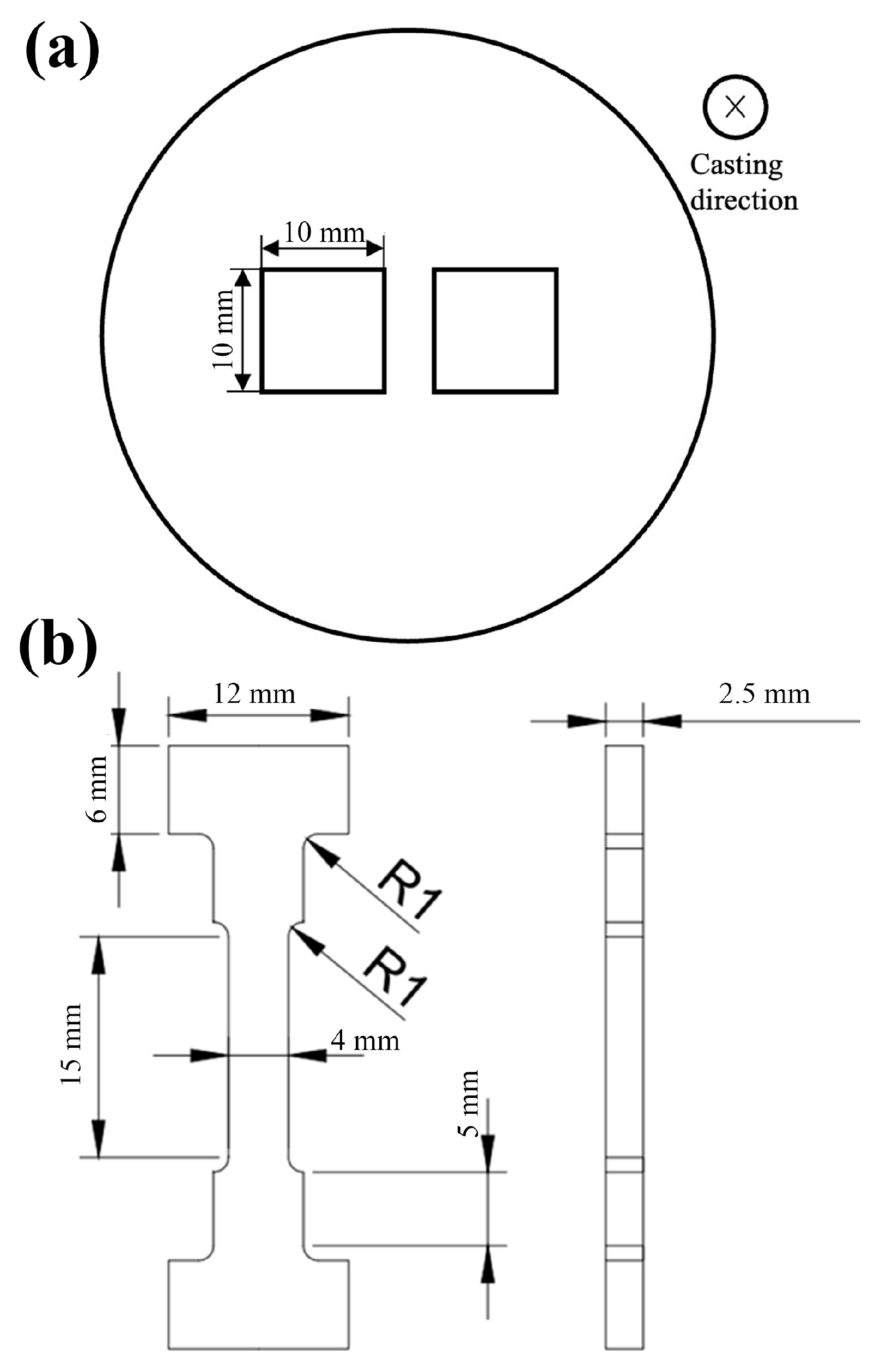
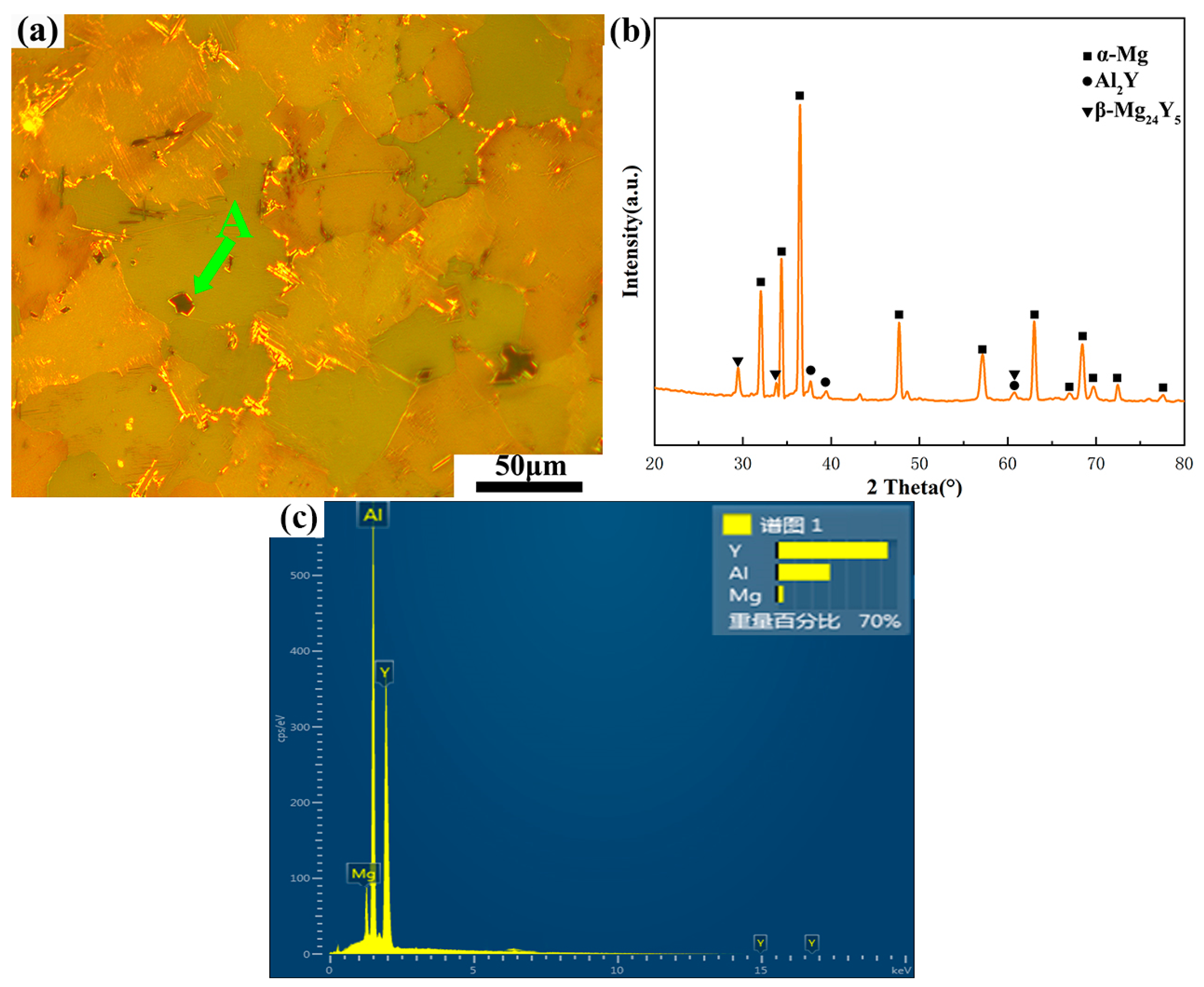

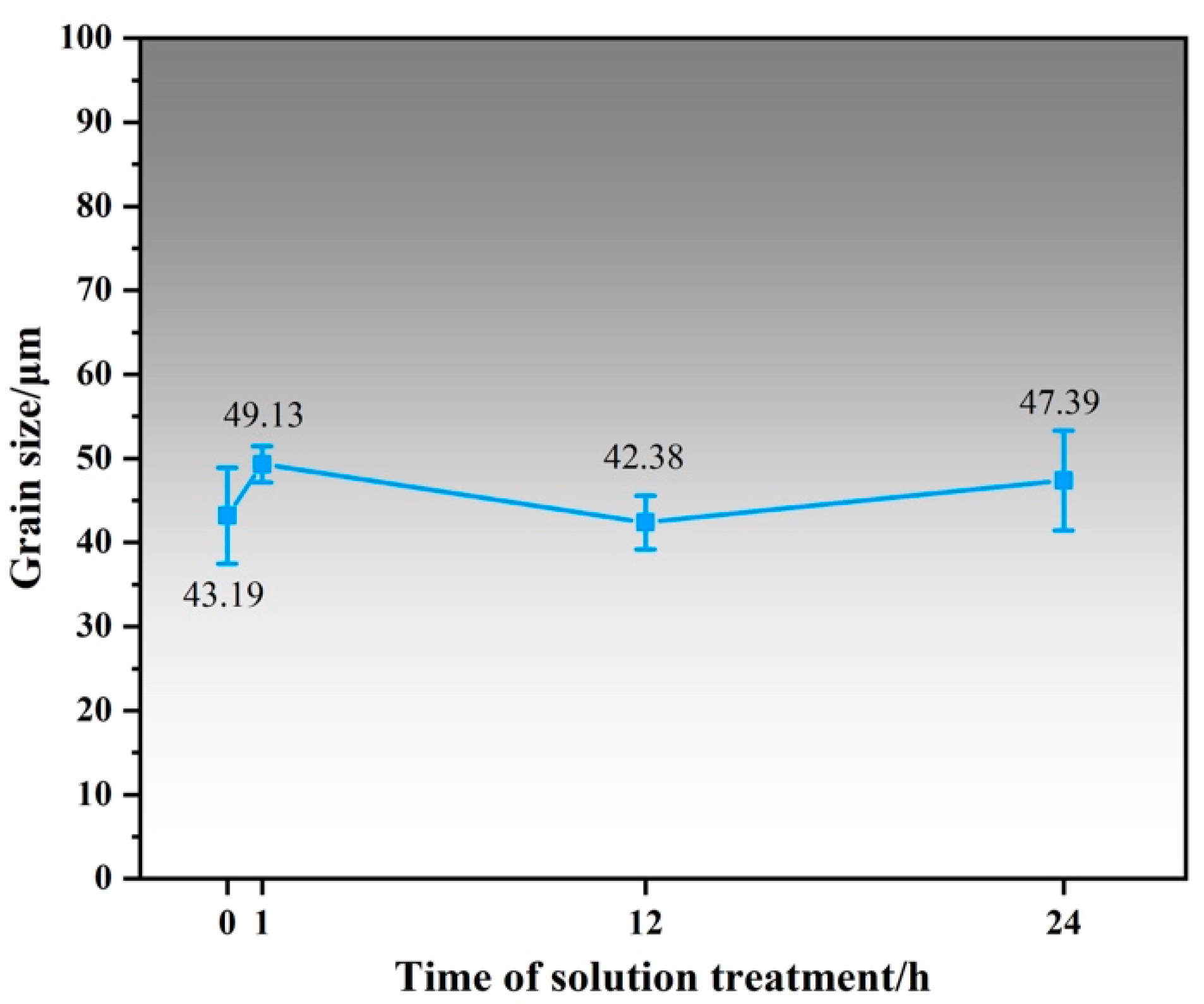

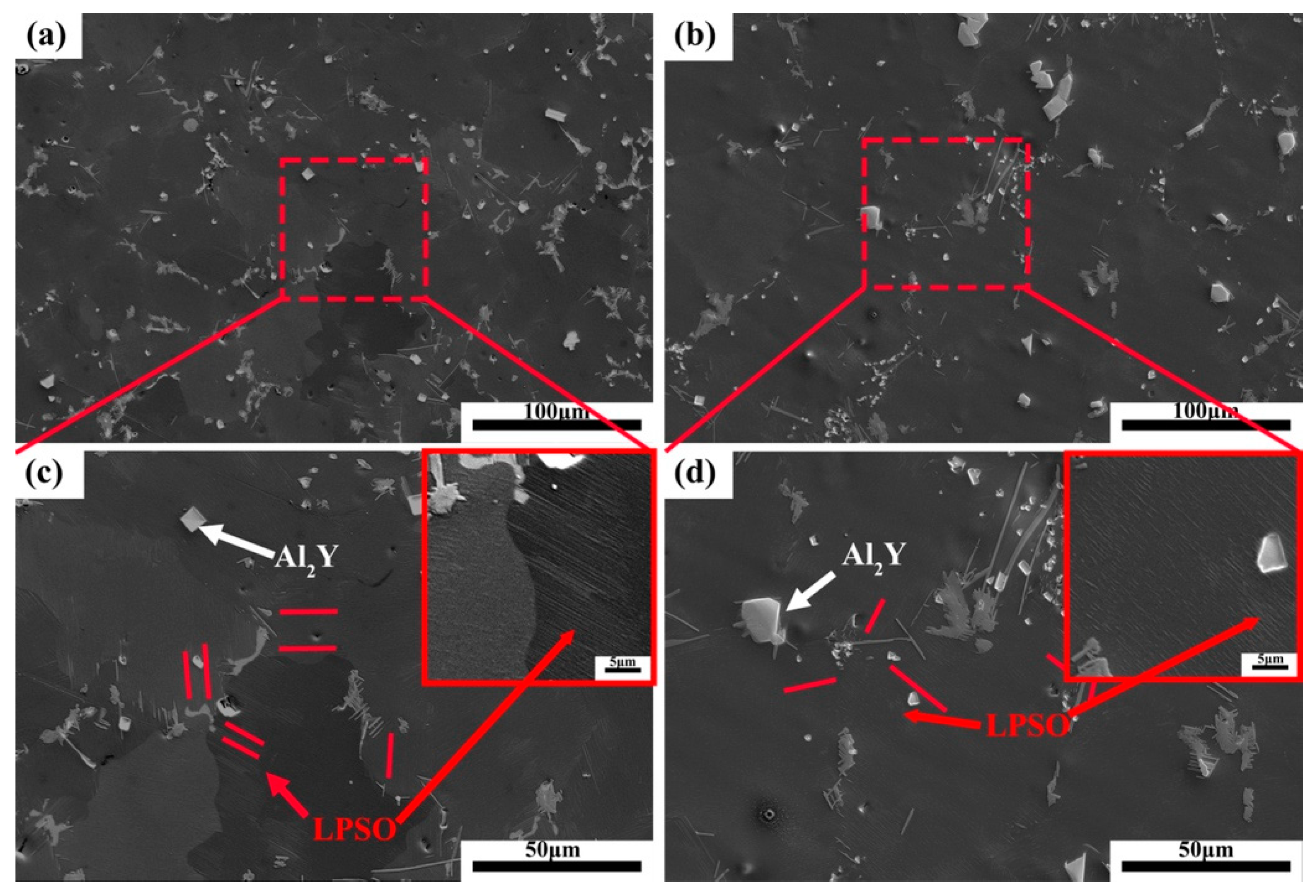

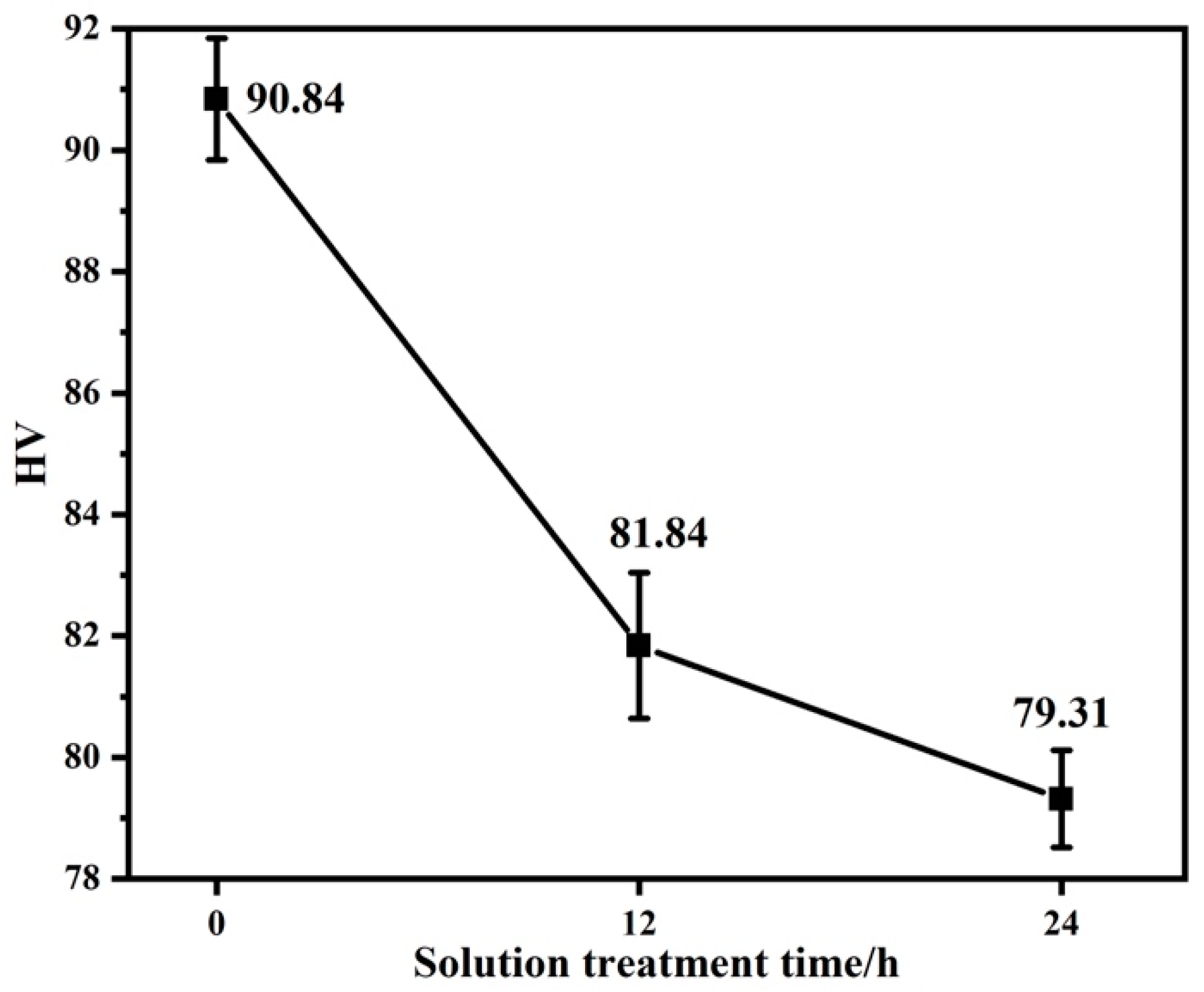


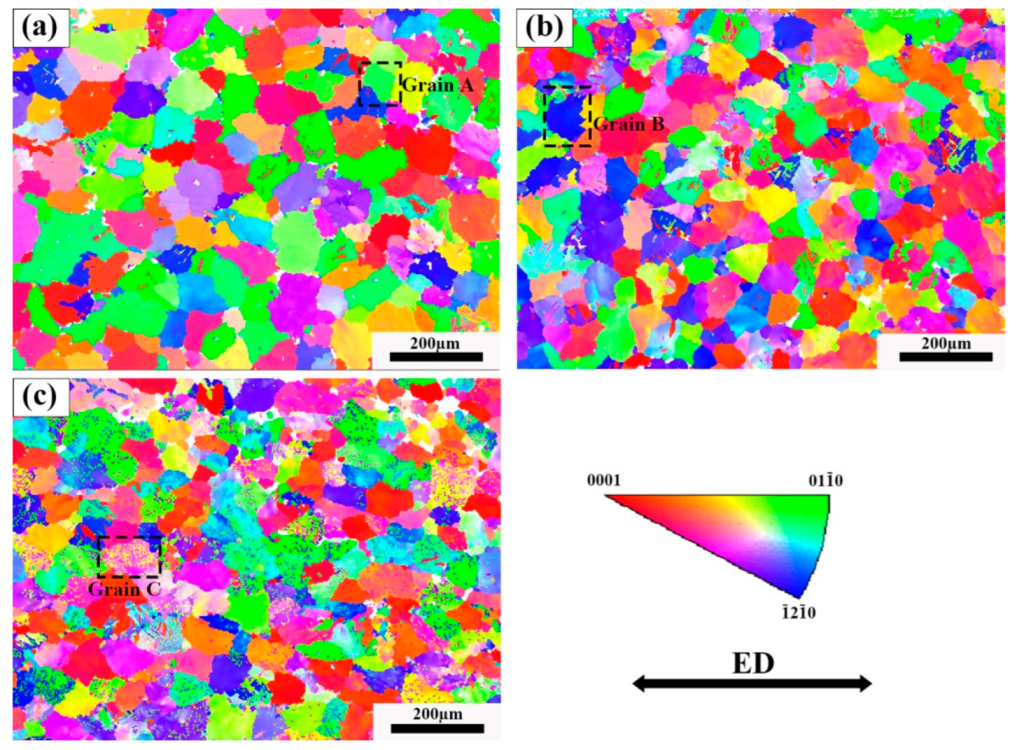

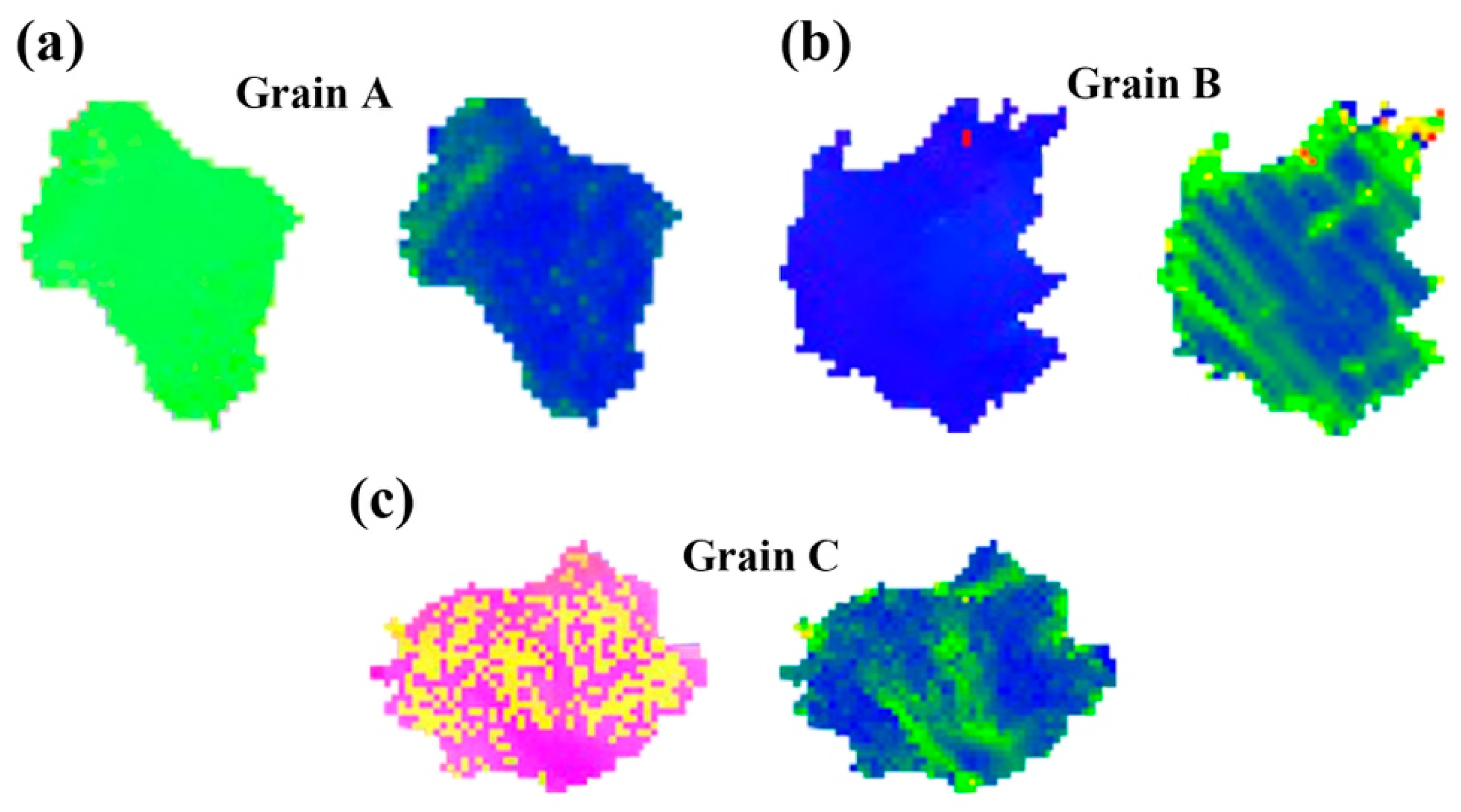
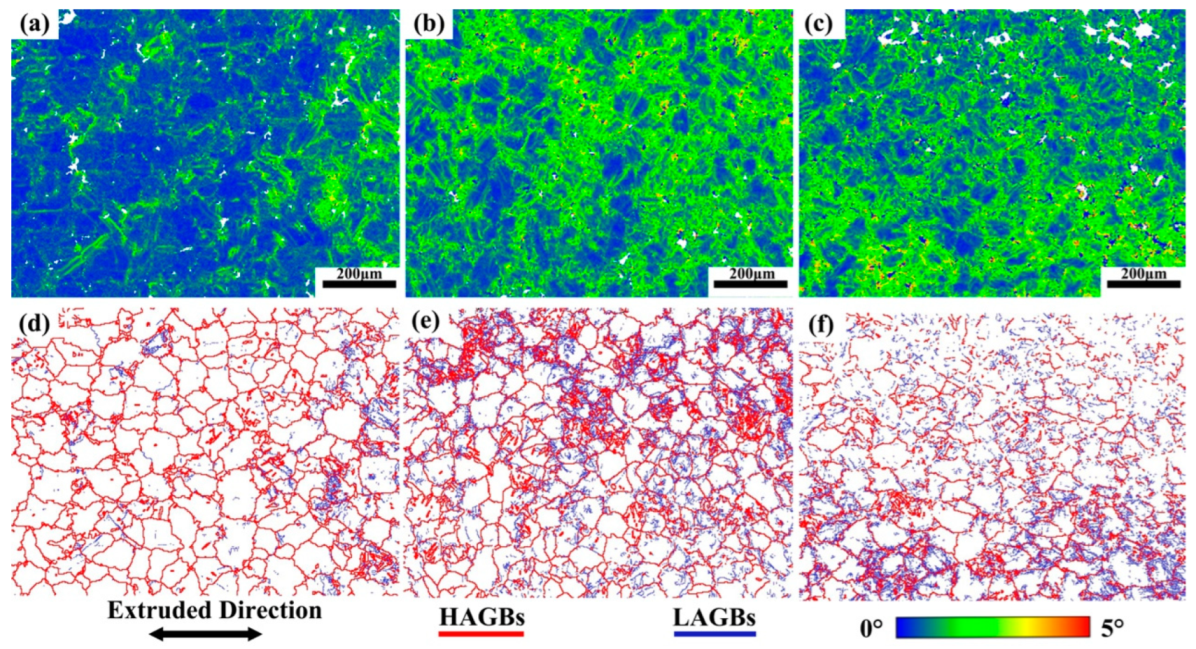

| Alloy | A | B | C |
|---|---|---|---|
| TYS MPa | 133.45 | 128.2 | 115.39 |
| UTS MPa | 156.99 | 169.27 | 166.26 |
| Elongation % | 4.2 | 7.8 | 12.4 |
| Alloy | A | B | C |
|---|---|---|---|
| AKAM | 0.7 | 1.14 | 1.13 |
| HAGBs % | 70 | 47.6 | 38.3 |
| LAGBs % | 30 | 52.4 | 61.7 |
Disclaimer/Publisher’s Note: The statements, opinions and data contained in all publications are solely those of the individual author(s) and contributor(s) and not of MDPI and/or the editor(s). MDPI and/or the editor(s) disclaim responsibility for any injury to people or property resulting from any ideas, methods, instructions or products referred to in the content. |
© 2023 by the authors. Licensee MDPI, Basel, Switzerland. This article is an open access article distributed under the terms and conditions of the Creative Commons Attribution (CC BY) license (https://creativecommons.org/licenses/by/4.0/).
Share and Cite
Ren, Q.; Yuan, S.; Wang, J.; Ma, D.; Li, W.; Wang, L. Microstructure and High-Temperature Mechanical Properties of Mg-1Al-12Y Alloy Containing LPSO Phase. Metals 2023, 13, 158. https://doi.org/10.3390/met13010158
Ren Q, Yuan S, Wang J, Ma D, Li W, Wang L. Microstructure and High-Temperature Mechanical Properties of Mg-1Al-12Y Alloy Containing LPSO Phase. Metals. 2023; 13(1):158. https://doi.org/10.3390/met13010158
Chicago/Turabian StyleRen, Qianlong, Shuai Yuan, Jinhui Wang, Deqing Ma, Wei Li, and Lei Wang. 2023. "Microstructure and High-Temperature Mechanical Properties of Mg-1Al-12Y Alloy Containing LPSO Phase" Metals 13, no. 1: 158. https://doi.org/10.3390/met13010158
APA StyleRen, Q., Yuan, S., Wang, J., Ma, D., Li, W., & Wang, L. (2023). Microstructure and High-Temperature Mechanical Properties of Mg-1Al-12Y Alloy Containing LPSO Phase. Metals, 13(1), 158. https://doi.org/10.3390/met13010158





